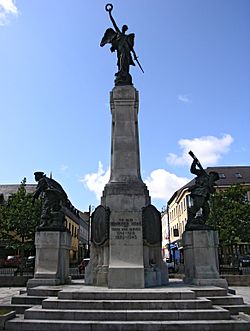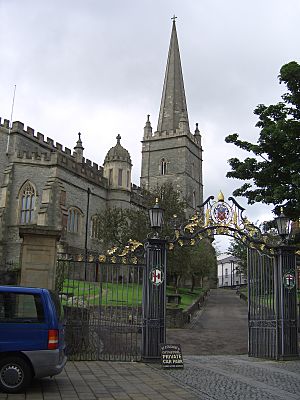Diamond War Memorial facts for kids
Quick facts for kids Diamond War Memorial |
|
|---|---|
| Northern Ireland | |
 |
|
| For soldiers who died and served in World War I and World War II | |
| Unveiled | 23 June 1927 |
| Location | 54°59′44″N 7°19′19″W / 54.99556°N 7.32194°W |
| Designed by | Sydney March and Vernon March |
|
To our honoured dead and those who served
1914–1918 1939–1945 |
|
The Diamond War Memorial stands proudly in the heart of Derry, Northern Ireland. It was built in 1927. This special monument remembers the brave people from the city who died serving in the military during World War I. It also honors those who served in World War II.
Contents
Planning the Memorial
In early 1919, leaders in Derry decided to create a memorial. They wanted to honor those who died in the Great War. The memorial would be made of granite or bronze. It would have the names of the fallen carved into it.
A fund called the City War Memorial Fund started in February 1919. It took several years to collect enough money. This money came from people giving donations. By 1924, some citizens were unhappy with how slowly things were going.
However, in April 1925, the design and location were approved. This was done by the city's War Memorial Committee. They still needed permission from the Londonderry Corporation. After some talks, they got the approval for the monument's spot.
Designing the Monument
The Diamond War Memorial was designed by two siblings. Their names were Sydney March and Vernon March. They came from a big family of artists. They had eight children who became artists. They even had a studio at their home in Farnborough, England.
Vernon March, one of the brothers, sculpted the monument. He and his siblings also created other famous memorials. One example is the National War Memorial in Ottawa, Canada. Vernon was very talented from a young age. He was the youngest person to show his art at the Royal Academy of Arts. He was only 16 when his statue was displayed there.
Vernon March also made smaller versions of the Diamond War Memorial. These miniatures are kept inside Saint Columb's Cathedral in Derry.
The memorial is made from bronze and Portland stone. Portland stone is a type of limestone. It comes from quarries on the Isle of Portland in England. The monument is almost 40 feet tall. It is also 27 feet wide.
In the center, there is a main monument. It has a winged victory statue. This statue holds a laurel wreath high. The names of the fallen are carved in raised letters on its four sides.
Near the bottom, there are two smaller bronze statues. One is a soldier, showing the Army. The other is a sailor, showing the Navy.
Derry is a walled city. It is sometimes called the Maiden City. It has four main gates. Roads from these gates lead to a central area called The Diamond. This is the heart of the city. The memorial, which is a cenotaph, stands right in the middle of The Diamond.
The design of this memorial is similar to one in Cape Town, South Africa. That memorial, called the Cenotaph, was also designed by March in 1924.
Dedication Ceremony

The Diamond War Memorial was officially revealed on June 23, 1927. Major-General F. F. Ready led the unveiling. He was the General Officer Commanding for Northern Ireland. Sir Robert Newton Anderson was supposed to lead the ceremony. He was the head of the War Memorial Committee. But he was sick and could not attend.
Many important people were there. This included relatives of the fallen soldiers. Also present were military groups and former regiments. Members of the United Kingdom's forces, clergy, and public officials attended. The British Legion served as an honor guard. A band and a large choir also took part.
After some music, Major-General Ready inspected the honor guard. Then, the hymn God of Our Fathers, Known of Old was sung. Lady Anderson, Sir Robert's wife, gave a short speech. She then asked the major-general to unveil the memorial.
Ready gave a brief speech and then revealed the monument. After the dedication, everyone observed a moment of silence. Then, the hymn O Valiant Hearts was sung. Buglers played The Last Post and Londonderry Air.
Lady Anderson officially handed over the memorial. She gave it to the mayor on behalf of the committee. The mayor accepted it for the Londonderry Corporation. Wreaths were placed on the monument. These were from citizens, the Northern Ireland District, and the British Legion.
After the national anthem, more flowers were placed. These were from families, military groups, and public bodies. The ceremony honored 756 citizens of Derry. They had died in World War I. It also honored 4,000 men and women who volunteered to serve.
Soldiers Remembered
The monument lists the names of many brave soldiers. Here are a few:
- Company Sergeant Major Robert Hamilton, who received two important medals: the Distinguished Conduct Medal and the Military Medal.
- Maurice Graham English, an aviator.
Diamond War Memorial Project
The Holywell Trust is a charity in Derry. It was started in 1988. Its goal is to research and share information. It focuses on World War I memorials in the North West of Ulster. This includes areas like County Londonderry, County Donegal, and County Tyrone. It also remembers the citizens who died in the war.
The trust began the Diamond War Memorial Project on February 12, 2007. A historian named Trevor Temple did a lot of research. He looked into the 756 names on the memorial.
This project also created a Commemorative Diary. It also made a website. The website lists all the names. It shares the personal stories of those on the memorial. The research found that the names included both unionist and nationalist people. This means the Diamond War Memorial is a shared monument for everyone in the city.

